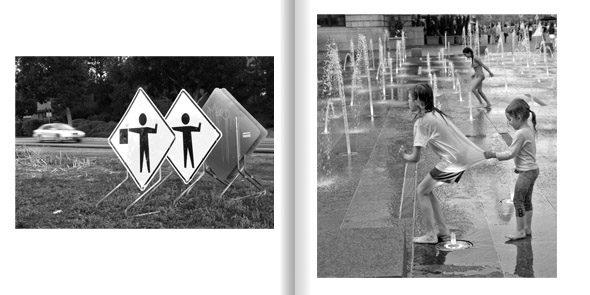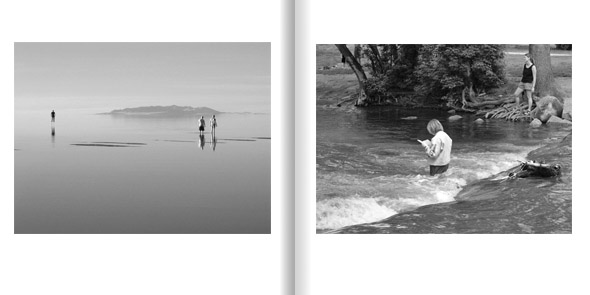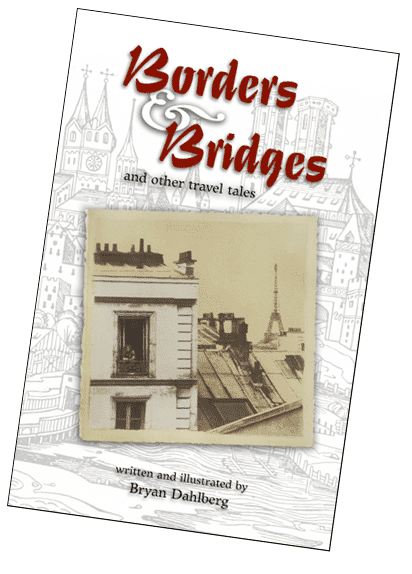
The personal publishing imprint of
Bryan Dahlberg
Return to Bryan Dahlberg's Photonbox website


The term “street photography” is a respected niche in the art form, right beside “nature photography,” “landscape,” “commercial,” “portrait,” “still life” and many others. That vision for me personally has been formed primarily by three great photographers of the urban scene: Robert Doisneau, Elliott Erwitt and Henri Cartier-Bresson. It is perhaps fitting that all of them were born in France, since France was the birthplace of photography. I have not tried to emulate them. I cannot hope to fill their shoes, but I find great personal satisfaction in attempting to follow in their footsteps.
The famous English term for Cartier-Bresson’s photographic philosophy is “the decisive moment.” The element of time – or timing – is essential to most practitioners of the style. It’s the necessity for incorporating four dimensions into the composition instead of the usual three – length, width and depth. To those add time.
Without the consideration of time, the picture would more likely be a landscape or a still life. But the energy and excitement of good street photography is more akin to sports photography, although usually at a less frenetic pace. The fact that the subjects are in unpredictable motion is a demanding challenge. But when the serendipitous arrangement of space and time is captured, it is uniquely satisfying.

The subject matter is in continuous movement; the environment is infinitely variable. The conjunction of people, place and time will never be repeated, and a photographer must have the patience to wait and anticipate, and be ready in an instant to make the capture.
For some of the pictures in this book I waited a long time – sometimes an hour in a single doorway or several hours for the shadows to move across the street. Sometimes I’ve been approached by curious passersby. One asked if I was an Associated Press photographer who had taken his photograph several years earlier. Others have struck an unnatural pose after noticing me aiming in their direction. Feigning interest, I would take one exposure to satisfy them and then stealthily make another after they stopped acting. And once, a police officer, intuitively understanding what I was doing, came up quietly beside me and helped me spot likely subjects approaching on the sidewalk. One of those pictures is in this book.

The human figure, whether portrayed in a classical landscape, a photographer’s studio or on a city street, gives us an essential perspective, a view of ourselves in the context of our environment. In an age when our visual perception of reality is increasingly distorted by instantaneous digital iconography, sophisticated virtual reality devices and unlimited computer manipulation, photography can and should be a reassuring confirmation of our relationship to the material world as well as a witness to our place in time.
“All the world’s a stage,” Shakespeare said, “and all the men and women merely players...”
For a passionate spectator, a street corner is the best seat in the house.
Paperback, 8.5 x 8.5", 184 pages, black and white photographs throughout
$30.00 ISBN 978-1-48358-449-2 Purchase here soon

For several
decades, I have collected books from the “Golden Age”
of illustrated travel writing — by authors like Ludwig Bemelmans,
S.J. Perelman, Rockwell Kent and Stephen Longstreet. Most of these books
were published between 1930 and the 1960s. They are not travel guides;
they are enduring examples of personal anecdote and observation, intensely
individual and full of character. Inspired by these warm, poignant and
often funny stories, and drawing on his many years of living in Europe,
I've turned my own travel tales into a collection that vividly evokes
days of innocent adventure and misadventure.
Whether the story involves smuggling literature behind the Iron Curtain
in an ancient camper van or teaching two young birds to fly behind a
Bavarian castle, the stories irresistibly invite the reader to come along
for the ride.
The charm of this book is expressed in much more than the text. My
own illustrations complement the words in both content and style, in a
variety of media. Most of the pictures are line drawings in the tradition
of my favorite authors and illustrators, but some are photographs created
by unusual methods. The cover photograph, for instance, is a gum bichromate
print. This technique was invented in 1855, and for several years I've been developing the process further. My gum prints and photo etchings have been
shown in many exhibits.
Table of Contents
Sample pages
Back cover

From the chapter Tram 27.
Paperback, 5.5 x 8.5", 240
pages, illustrated throughout
$14.00 ISBN 0-9754700-1-9 ![]() Purchase
here
Purchase
here
What they’re saying...
“It is some of the best ‘travel
writing’ I have ever read, being so much more than travel writing.”
![]() — Steven J.
Meyers, author of Lime Creek Odyssey,
Notes from the
— Steven J.
Meyers, author of Lime Creek Odyssey,
Notes from the ![]() San
Juans, Streamside Reflections, etc.
San
Juans, Streamside Reflections, etc.
“Borders and Bridges
is a superb read! I finished it last night and wanted you to know that
I enjoyed the fascinating stories, but even more I enjoyed the way they
were told. You have a writing style and voice that are the perfect balance
of thought-provoking and amusing. And you’ve taken your talent for
exceedingly interesting turns of phrase and applied it to some very
interesting experiences.”
![]() —
Dr. David Livingston, former Executive Director of Elementary Education,
—
Dr. David Livingston, former Executive Director of Elementary Education,
![]() Cherry Creek Schools,
Englewood, Colorado
Cherry Creek Schools,
Englewood, Colorado
“Thank you for showing me
now what creative writing is all about. Thank you for gifting me with
this literary gem.”
![]() — Dr. Mel
Lorentzen, former professor of English, Wheaton College
— Dr. Mel
Lorentzen, former professor of English, Wheaton College